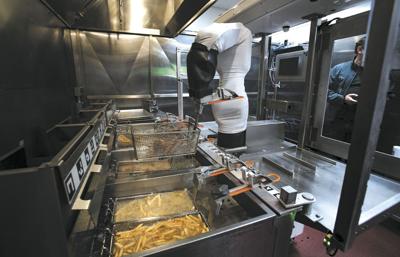On April 1, more than half a million fast-food workers in California got a raise, with minimum wage across the sector bumped up to $20 per hour. That same week, the selfproclaimed “world’s first fully autonomous restaurant” opened its doors for business in Pasadena.
These two stories have received considerable media attention, typically presented as fundamentally linked: Fast-food franchise owners are struggling to stay afloat amid rising labor costs, leading many to consider automation as the only viable solution. But this simple depiction of cause and effect paints a picture of innovation and inevitability that sells the public on a fanciful myth.
I study low-wage industries in Los Angeles County, including the effects of new technology on workers. My research shows how automation does not always lead to greater efficiency and cost-cutting for businesses, as AI boosters would like the public — and policymakers — to believe. This kind of innovation also promises to further income inequality. Working people deserve to have their voices heard in determining how, where, when or whether AI and automation should be used.
I was eager to visit CaliExpress, the new roboticized Pasadena restaurant, to learn what the future of fast food looked (and tasted) like. Outside there were slogans befitting a traveling circus: “AI FRYING ROBOT MARVEL!” My curiosity piqued, I entered, passing by a facial recognition scanner advertising the ominous-sounding opportunity to “pay with your face.”
I placed my order on a giant touchscreen and watched a human worker spring into action behind the counter. They rushed to load up robots with raw beef and frozen fries and scrambled around the kitchen retrieving cooked items that the robots had deposited into buckets. Then this person manually assembled, packaged and delivered the food to waiting customers. A second worker cleaned upĚýafter the robots.
As an animatronic arm put on a show reminiscent of a kooky science fair project — hastily dunking a fry basket into a vat of hot oil — the workers toiled away in the background,Ěýdoing the majority of theĚýwork.
As with so many AI stories, humans remain mission-critical. Examples abound, from Amazon’s “Just Walk Out” stores to local food delivery bots. Each demonstrates how the lofty promises of new technology can be used as a pretense for restructuring industries and infrastructure, often at the expense of workers, consumers and the community.
Automation often provides cover for employers to double down on costcutting measures that lead to chronic understaffing, which increases the likelihood of injury and wage theft. While automation may reduce marginal labor costs, there is little evidence that it necessarily improves productivity, safety or cost-effectiveness.
Integrating automation in the service sector often results in fewer workers doing more work, as I observed at CaliExpress. Economists have clocked this phenomenon as well, documenting enormous growth in revenue-per-employee in fast food over the last five years. This indicates that productivity and wealth concentration are already growing hand-in-hand, even before any automation — a sobering finding that chafes with the narrative that unsustainable labor costs are automation’s main driver.
Likewise, consumers endĚýup paying more for less,Ěýas automation requiresĚýhigh levels of standardization.
In fast food, this means small menus with minimal customization. Food prices, meanwhile, will continue to skyrocket, just as they have over the last decade, far outpacing the rate of inflation and boosting corporate profits to unprecedented new heights. My order at CaliExpress — a burger and fries, the extent of their current menu — came out to $15.44, more than double the same order at In-NOut.
As profits boom for multinational conglomerates, local franchisees may feel pressure to automate. But to fully renovate a commercial kitchen requires enormous and risky capital investment, plunging already struggling small businesses into new debt.
So who actually stands to gain from automation and AI?
The winner is a new class of techno- middlemen, hawking leased hardware and subscription-based software solutions to the public and private sectors. The companies developing this technology have raised billions to impose their “solutions” onto the unwitting public, with scant input from workers, small business owners or consumers. The fast-food industry is the latest test kitchen for these ideas.
Fortunately, California has a reputation for taking bold policy action.
Along with the minimum wage increase, Assembly Bill 1228 also established the state’s first “sectoral bargaining” councils, where workers and employers come together to collectively determine industry-wide standards and protections — including, hopefully, the role of new technology in the workplace.
This is a radical development in the pursuit of workplace democracy. And its timing is fortunate, given the rapid and unchecked ascendancy of automation and AI, further evidenced by Gov. Gavin ÁůşĎ˛ĘżŞ˝±ĽÇÂĽom’s recent executive order mandating an AI-powered overhaul of state government operations and public services. But until ideas like sectoral bargaining and a living wage for all become commonplace, there is a real risk that AI and automation will merely accelerate inequality.
Unlike unproven AI novelties, California’s new fast-food bill is a form of innovation we should demand policymakers invest in, as it will lift thousands out of poverty and give marginalized workers a seat at the table. That’s more transformative than anything being cooked up in Silicon Valley.
(Brian Justie is a senior research analyst at the UCLA Labor Center.)








